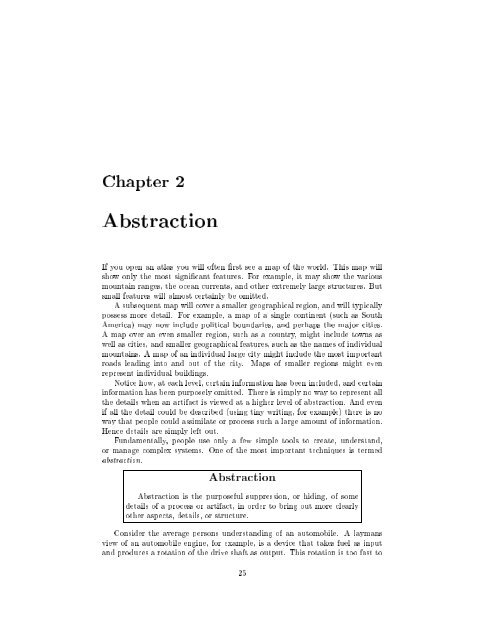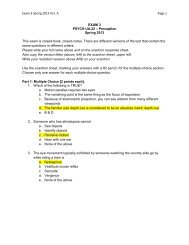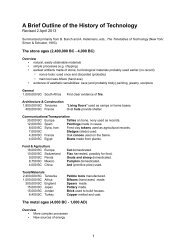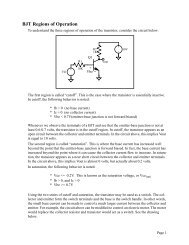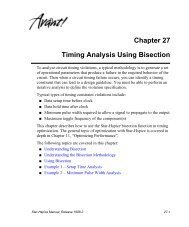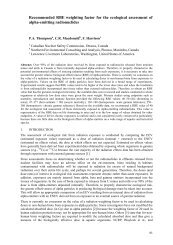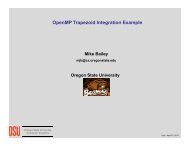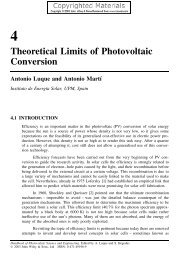Chapter 2: Abstraction
Chapter 2: Abstraction
Chapter 2: Abstraction
You also want an ePaper? Increase the reach of your titles
YUMPU automatically turns print PDFs into web optimized ePapers that Google loves.
<strong>Chapter</strong> 2<br />
<strong>Abstraction</strong><br />
If you open an atlas you will often rst see a map of the world. This map will<br />
show only the most signi cant features. For example, it may show the various<br />
mountain ranges, the ocean currents, and other extremely large structures. But<br />
small features will almost certainly be omitted.<br />
A subsequent map will cover a smaller geographical region, and will typically<br />
possess more detail. For example, a map of a single continent (such as South<br />
America) may now include political boundaries, and perhaps the major cities.<br />
A map over an even smaller region, such as a country, might include towns as<br />
well as cities, and smaller geographical features, such as the names of individual<br />
mountains. A map of an individual large city might include the most important<br />
roads leading into and out of the city. Maps of smaller regions might even<br />
represent individual buildings.<br />
Notice how, at each level, certain information has been included, and certain<br />
information has been purposely omitted. There is simply no way to represent all<br />
the details when an artifact is viewed at a higher level of abstraction. And even<br />
if all the detail could be described (using tiny writing, for example) there is no<br />
way that people could assimilate or process such a large amount of information.<br />
Hence details are simply left out.<br />
Fundamentally, people use only a few simple tools to create, understand,<br />
or manage complex systems. One of the most important techniques is termed<br />
abstraction.<br />
<strong>Abstraction</strong><br />
<strong>Abstraction</strong> is the purposeful suppression, or hiding, of some<br />
details of a process or artifact, in order to bring out more clearly<br />
other aspects, details, or structure.<br />
Consider the average persons understanding of an automobile. A laymans<br />
view of an automobile engine, for example, is a device that takes fuel as input<br />
and produces a rotation of the drive shaft as output. This rotation is too fast to<br />
25
26 CHAPTER 2. ABSTRACTION<br />
connect to the wheels of the car directly, so a transmission is a mechanism used<br />
to reduce a rotation of several thousand revolutions per minute to a rotation of<br />
several revolutions per minute. This slower rotation can then be used to propel<br />
the car. This is not exactly correct, but it is su ciently close for everyday<br />
purposes. We sometimes say that by means of abstraction we have constructed<br />
a model of the actual system.<br />
fuel XXXXXXXX<br />
transmission<br />
engine<br />
In forming an abstraction, or model, we purposely avoid the need to understand<br />
many details, concentrating instead of a few key features. We often<br />
describe this process with another term, information hiding.<br />
Information Hiding<br />
Information hiding is the purposeful omission of details in the<br />
development of an abstract representation.<br />
2.1 Layers of <strong>Abstraction</strong><br />
Inatypical program written in the object-oriented style there are many important<br />
levels of abstraction. The higher level abstractions are part of what makes<br />
an object-oriented program object-oriented.<br />
At the highest level a program is viewed as a \community" of objects that<br />
must interact with each other in order to achieve their common goal:<br />
, @<br />
AAAAAAAAA<br />
, @<br />
, @<br />
XXXXXXX<br />
, @<br />
, @ HHHHH<br />
, @<br />
, @<br />
@@<br />
@<br />
, @
2.1. LAYERS OF ABSTRACTION 27<br />
This notion of community nds expression in object-oriented development<br />
in two distinct forms. First there is the community of programmers, who must<br />
interact with each other in the real world in order to produce their application.<br />
And second there is the community of objects that they create, which must<br />
interact with each other in a virtual universe in order to further their common<br />
goals. Key ideas such as information hiding and abstraction are applicable to<br />
both levels.<br />
Each object in this community provides a service that is used by other members<br />
of the organization. At this highest level of abstraction the important<br />
features to emphasize are the lines of communication and cooperation, and the<br />
way in which the members must interact with each other.<br />
The next level of abstraction is not found in all object-oriented programs,<br />
nor is it supported in all object-oriented languages. However, many languages<br />
permit a group of objects working together to be combined into a unit. Examples<br />
of this idea include packages in Java, name spaces in C++, or units in Delphi.<br />
The unit allows certain names to be exposed to the world outside the unit, while<br />
other features remain hidden inside the unit.<br />
'<br />
, @ HHHHH<br />
, @<br />
, @<br />
&<br />
$<br />
Package<br />
"DataStructures"<br />
@@<br />
@<br />
, @<br />
%<br />
For readers familiar with concepts found in earlier languages, this notion of<br />
a unit is the heir to the idea of a module in languages such as C or Modula.<br />
Later in this chapter we will present a short history of programming language<br />
abstractions, and note the debt that ideas of object-oriented programming owe<br />
to the earlier work on modules.<br />
The next two levels of abstraction deal with the interactions between two<br />
individual objects. Often we speak of objects as proving a service to other<br />
objects. We build on this intuition by describing communication as an interaction<br />
between a client and a server.
28 CHAPTER 2. ABSTRACTION<br />
~<br />
, ,,@ @ @<br />
Client<br />
-<br />
~<br />
, ,,@ @ @<br />
Server<br />
We are not using the term server in the technical sense of, say, aweb server.<br />
Rather, here the term server simply means an object that is providing a service.<br />
The two layers of abstraction refer to the two views of this relationship; the view<br />
from the client side and the view from the server side.<br />
In a good object-oriented design we can describe and discuss the services<br />
that the server provides without reference to any actions that the client may<br />
perform in using those services. One can think of this as being like a billboard<br />
advertisement:<br />
Services O ered:<br />
void push (Object val); $1<br />
Object top (); $1<br />
void pop (); $0.75<br />
Joe's Data Structure Warehouse<br />
\For All your Data Structure Needs!"<br />
The billboard describes, for example, the services provided by a data structure,<br />
such asaStack. Often this level of abstraction is represented by aninterface,<br />
a class-like mechanism that de nes behavior without describing an implementation:<br />
interface Stack f<br />
public void push (Object val);<br />
public Object top () throws EmptyStackException;<br />
public void pop () throws EmptyStackException;<br />
g
2.1. LAYERS OF ABSTRACTION 29<br />
Finding the Right Level of <strong>Abstraction</strong><br />
In early stages of software development a critical problem is nding the right<br />
level of abstraction. A common error is to dwell on the lowest levels, worrying<br />
about the implementation details of various key components, rather than striving<br />
to ensure that the high level organizational structure promotes a clean separation<br />
of concerns.<br />
The programmer (or, in larger projects, the design team) must walk a ne line<br />
in trying to identify the right level of abstraction at any one point of time. One<br />
does not want to ignore or throw away toomuch detail about a problem, but also<br />
one must not keep so much detail that important issues become obscured.<br />
The next level of abstraction looks at the same boundary but from the server<br />
side. This level considers a concrete implementation of the abstract behavior.<br />
For example, there are any number of data structures that can be used to satisfy<br />
the requirements of a Stack. Concerns at this level deal with the way in which<br />
the services are being realized.<br />
public class LinkedList implements Stack ... f<br />
public void pop () throws EmptyStackException f ... g<br />
...<br />
g<br />
Finally, the last level of abstraction considers a single task in isolation; that<br />
is, a single method. Concerns at this level of abstraction deal with the precise<br />
sequence of operations used to perform just this one activity. For example, we<br />
might investigate the technique used to perform the removal of the most recent<br />
element placed into a stack.<br />
public class LinkedList implements Stack ... f<br />
...<br />
public void pop () throws EmptyStackException f<br />
if (isEmpty())<br />
throw new EmptyStackException();<br />
removeFirst(); // delete rst element of list<br />
g<br />
g<br />
...<br />
Each level of abstraction is important at some point during software development.<br />
In fact, programmers are often called upon to quickly move back and forth<br />
between di erent levels of abstraction. We will see analysis of object-oriented
30 CHAPTER 2. ABSTRACTION<br />
division<br />
into parts<br />
abstraction AAAAAAAAAA multiple views<br />
specialization class hierarchies<br />
service view<br />
repetition<br />
A AAAAAAA catalogs<br />
H HHH<br />
HXXXX HHH<br />
XXXX<br />
ADT<br />
patterns<br />
Figure 2.1: Some Techniques for Handling Complexity, with Examples<br />
object oriented programs<br />
mathematical induction<br />
recursive algorithms<br />
recursive data structures<br />
composition<br />
cross references<br />
dictionaries<br />
programs performed at each of these levels of abstraction as we proceed through<br />
the book.<br />
2.2 Other Forms of <strong>Abstraction</strong><br />
<strong>Abstraction</strong> is used to help understand a complex system. In a certain sense,<br />
abstraction is the imposition of structure on a system. The structure we impose<br />
may re ect some real aspects of the system (a car really does have both an engine<br />
and a transmission) or it may simply be a mental abstraction we employ toaid<br />
in our understanding.<br />
This idea of abstraction can be further subdivided intoavariety of di erent<br />
forms (Figure 2.1). A common technique is to divide a layer into constituent<br />
parts. This is the approach we used when we described an automobile as being<br />
composed of the engine, the transmission, the body and the wheels. The next<br />
level of understanding is then achieved by examining each of these parts in turn.<br />
This is nothing more than the application of the old maxim divide and conquer.<br />
Other times we use di erent types of abstraction. Another form is the idea<br />
of layers of specialization (Figure 2.2). An understanding of an automobile is<br />
based, in part, on knowledge that it is a wheeled vehicle, which is in turn a means<br />
of transportation. There is other information we know about wheeled vehicles,<br />
and that knowledge is applicable to both an automobile and a bicycle. There is<br />
other knowledge we have about various di erent means of transportation, and<br />
that information is also applicable to pack horses as well as bicycles. Object
2.2. OTHER FORMS OF ABSTRACTION 31<br />
wheeled vehicle<br />
,<br />
bicycle<br />
, @ automobile<br />
means of transportation<br />
H HH<br />
pack horse<br />
Figure 2.2: Layers of Specialization<br />
Is-a and Has-a <strong>Abstraction</strong><br />
The ideas of division into parts and division into specializations represent the two<br />
most important forms of abstraction used in object-oriented programming. These<br />
are commonly known as is-a and has-a abstraction.<br />
The idea of division into parts is has-a abstraction. The meaning of this term is<br />
easy to understand; a car \has-a" engine, and it \has-a" transmission, and so on.<br />
The concept of specialization is referred to as \is-a" abstraction. Again, the term<br />
comes from the English sentences that can be used to illustrate the relationships.<br />
A bicycle \is-a" wheeled vehicle, which in turn \is-a" means of transportation.<br />
Both is-a and has-a abstractions will reappear in later chapters and be tied to<br />
speci c programming language features.<br />
oriented languages make extensive use of this form of abstraction.<br />
Yet another form of abstraction is to provide multiple views of the same<br />
artifact. Each of the views can emphasize certain detail and suppress others,<br />
and thus bring out di erent features of the same object. Alaymans view of a<br />
car, for example, is very di erent from the view required by a mechanic.<br />
2.2.1 Division into Parts<br />
The most common technique people use to help understand complex systems is<br />
to combine abstraction with a division into component parts. Our description<br />
of an automobile is an example of this. The next level of understanding is then<br />
achieved by taking each of the parts, and performing the same sort of analysis<br />
at a ner level of detail. A slightly more precise description of an engine, for<br />
example, views it as a collection of cylinders, each of which converts an explosion<br />
of fuel intoavertical motion, and a crankshaft, which converts the up and down<br />
motion of the cylinder into a rotation.
32 CHAPTER 2. ABSTRACTION<br />
6<br />
?<br />
B<br />
B<br />
B<br />
B<br />
B<br />
, ,B<br />
Another example might be organizing information about motion in a human<br />
body. At one level we are simply concerned with mechanics, and we consider the<br />
body as composed of bone (for rigidity), muscles (for movement), eyes and ears<br />
(for sensing), the nervous system (for transferring information) and skin (to bind<br />
it all together). At the next level of detail we might ask how the muscles work,<br />
and consider issues such as cell structure and chemical actions. But chemical<br />
actions are governed by their molecular structure. And to understand molecules<br />
we break them into their individual atoms.<br />
Any explanation must be phrased at the right level of abstraction; trying to<br />
explain how a person can walk, for example, by understanding the atomic level<br />
details is almost certainly di cult, if not impossible.<br />
2.2.2 Encapsulation and Interchangeability<br />
A key step in the creation of large systems is the division into components.<br />
Suppose instead of writing software, we are part of a team working to create<br />
a new automobile. By separating the automobile into the parts engine and<br />
transmission, it is possible to assign people to work on the two aspects more or<br />
less independently of each other. We use the term encapsulation to mean that<br />
there is a strict division between the inner and the outer view; those members of<br />
the team working on the engine need only an abstract (outside, as it were) view<br />
of the transmission, while those actually working on the transmission need the<br />
more detailed inside view.<br />
An important bene t of encapsulation is that it permits us to consider the<br />
possibility ofinterchangeability. When we divide a system into parts, a desirable<br />
goal is that the interaction between the parts is kept to a minimum. For example,<br />
by encapsulating the behavior of the engine from that of a transmission we permit<br />
the ability to exchange one type of engine with another without incurring an<br />
undue impact on the other portions of the system.<br />
For these ideas to be applicable to software systems, we needaway to discuss<br />
the task that a software component performs, and separate this from the way in<br />
which the component ful lls this responsibility.
2.2. OTHER FORMS OF ABSTRACTION 33<br />
Catalogs<br />
When the number of components in a system becomes large it is often useful to<br />
organize the items by means of a catalog. We use many di erent forms of catalog in<br />
everyday life. Examples include a telephone directory, a dictionary, oraninternet<br />
search engine. Similarly, there are a variety of di erent catalogs used in software.<br />
One example is a simple list of classes. Another catalog might be the list of methods<br />
de ned by a class. A reference book that describes the classes found in the Java<br />
standard library is a very useful form of catalog. In each of these cases the idea is<br />
to provide the user a mechanism to quickly locate a single part (be it class, object,<br />
or method) from a larger collection of items.<br />
2.2.3 Interface and Implementation<br />
In software we use the terms interface and implementation to describe the distinction<br />
between the what aspects of a task, and the how features; between the<br />
outside view, and the inside view. An interface describes what a system is designed<br />
to do. This is the view that users of the abstraction must understand.<br />
The interface says nothing about how the assigned task is being performed. So to<br />
work, an interface is matched with an implementation that completes the abstraction.<br />
The designers of an engine will deal with the interface to the transmission,<br />
while the designers of the transmission must complete an implementation of this<br />
interface.<br />
Similarly, akey step along the path to developing complex computer systems<br />
will be the division of a task into component parts. These parts can then be<br />
developed by di erent members of a team. Each component will have two faces,<br />
the interface that it shows to the outside world, and an implementation that it<br />
uses to ful ll the requirements of the interface.<br />
The division between interface and implementation not only makes it easier<br />
to understand a design at a high level (since the description of an interface<br />
is much simpler than the description of any speci c implementation), but also<br />
make possible the interchangeability of software components (as I can use any<br />
implementation that satis es the speci cations given by the interface).<br />
2.2.4 The Service View<br />
The idea that an interface describes the service provided by a software component<br />
without describing the techniques used to implement the service is at the<br />
heart of a much more general approach to managing the understanding of complex<br />
software systems. It was this sort of abstraction that we emphasized when<br />
we described the ower story in <strong>Chapter</strong> 1. Ultimately in that story a whole<br />
community of people became involved in the process of sending owers:
34 CHAPTER 2. ABSTRACTION<br />
Robin<br />
Chris Fred<br />
Flower Arranger<br />
@ ,<br />
@<br />
Robin's Florist<br />
,<br />
Delivery Person<br />
E<br />
E<br />
E<br />
E<br />
E<br />
E<br />
Gardeners<br />
C<br />
C<br />
Grower<br />
Wholesaler<br />
Each member of the community isproviding a service that is used by other<br />
members of the group. No member could solve the problem on their own, and<br />
it is only by working together that the desired outcome is achieved.<br />
2.2.5 Composition<br />
Composition is another powerful technique used to create complex structures<br />
out of simple parts. The idea is to begin with a few primitive forms, and add<br />
rules for combining forms to create new forms. The key insight in composition<br />
is to permit the combination mechanism to be used both on the new forms as<br />
well as the original primitive forms.<br />
A good illustration of this technique is the concept of regular expressions.<br />
Regular expressions are a simple technique for describing sets of values, and have<br />
been extensively studied by theoretical computer scientists. The description of a<br />
regular expression begins by identifying a basic alphabet, for example the letters<br />
a, b, c and d. Any single example of the alphabet is a regular expression. We<br />
next add a rule that says the composition of two regular expressions is a regular<br />
expression. By applying this rule repeatedly we see that any nite string of<br />
letters is a regular expression:<br />
abaccaba<br />
The next combining rule says that the alternation (represented by the vertical<br />
bar j) oftwo regular expressions is a regular expression. Normally we give this<br />
rule a lower precedence that composition, so that the following pattern represents<br />
the set of three letter values that begin with ab, and and end with either an a,<br />
cord:<br />
aba j abc j abd<br />
Parenthesis can be used for grouping, so that the previous set can also be described<br />
as follows:<br />
ab(ajcjd)<br />
Finally the symbol (technically known as the kleene-star) is used to represent<br />
the concept \zero or more repetitions". By combining these rules we can describe<br />
quite complex sets. For example, the following describes the set of values that<br />
begin with a run of a's and b's followed by a single c, or a two character sequence<br />
dd, followed by the letter a.
2.2. OTHER FORMS OF ABSTRACTION 35<br />
(((ajb)*c)jdd)a<br />
This idea of composition is also basic to type systems. We begin with the<br />
primitive types, such asint and boolean. The idea of a class then permits the<br />
user to create new types. These new types can include data elds constructed<br />
out of previous types, either primitive or user-de ned. Since classes can build<br />
on previously de ned classes, very complex structure can be constructed piece<br />
by piece.<br />
class Box f // a box is a new data type<br />
...<br />
private int value; // built out of the existing type int<br />
g<br />
Yet another application of the principle of composition is the way that many<br />
user interface libraries facilitate the layout of windows. A window is composed<br />
from a few simple data types, such as buttons, sliders, and drawing panels.<br />
Various di erent types of layout managers create simple structures. For example,<br />
a grid layout de nes a rectangular grid of equal sized components, a border layout<br />
manger permits the speci cation of up to ve components in the north, south,<br />
east, west, and center of a screen. As with regular expressions, the key is that<br />
windows can be structured as part of other windows. Imagine, for example, that<br />
we want to de ne a window that has three sliders on the left, a drawing panel in<br />
the middle, a bank of sixteen buttons organized four by four on the right, and a<br />
text output box running along the top. (We will develop just such an application<br />
in <strong>Chapter</strong> 22. A screen shot is shown in Figure 22.4.) We can do this by laying<br />
simple windows inside of more complex windows (Figure 2.3).<br />
Many computer programs can themselves be considered a product of composition,<br />
where the method or procedure call is the mechanism of composition. We<br />
begin with the primitive statements in the language (assignments and the like).<br />
With these we can develop a library of useful functions. Using these functions as<br />
new primitives, we can then develop more complex functions. We continue, each<br />
layer being built on top of earlier layers, until eventually we have the desired<br />
application.<br />
2.2.6 Layers of Specialization<br />
Yet another approach to dealing with complexity is to structure abstraction using<br />
layers of specialization. This is sometimes referred to as a taxonomy. For example,<br />
in biology we divide living things into animals and plants. Living things are<br />
then divided into vertebrates and invertebrates. Vertebrates eventually includes<br />
mammals, which can be divided into (among other categories) cats and dogs,<br />
and so on.<br />
The key di erence between this and the earlier abstraction is that the more<br />
specialized layers of abstraction (for example, a cat) is indeed a representative
36 CHAPTER 2. ABSTRACTION<br />
( ( ( (<br />
( ( ( ( Hhhhhhhhhh (<br />
HH<br />
P PP P<br />
Color = [40,60,50]<br />
Color =<br />
XXXXXX<br />
H HH<br />
Figure 2.3: Composition in the Creation of User Interfaces<br />
:::<br />
Nonstandard Behavior<br />
Phyl and his friends remind us that there are almost never generalizations without<br />
their being exceptions. A platypus (such asphyl) is a mammal that lays eggs.<br />
Thus, while we might associate the tidbit of knowledge \gives birth to live young"<br />
with the category Mammal, we then need to amend this with the caveat \lays eggs"<br />
when we descend to the category Platypus.<br />
Object-oriented languages will also need a mechanism to override information<br />
inherited from a more general category. We will explore this in more detail once we<br />
have developed the idea of class hierarchies.
2.2. OTHER FORMS OF ABSTRACTION 37<br />
Object<br />
Component<br />
Button Checkbox Choice Container Label List Scrollbar Canvas<br />
Q<br />
XXXXXXXX<br />
QQ<br />
TextComponent Panel Window ScrollPanel<br />
Q Q<br />
QQ<br />
QQ<br />
TextArea TextField Dialog Frame<br />
Figure 2.4: The AWT class hierarchy<br />
of the more general layer of abstraction (for example, an animal). This was not<br />
true when, in an earlier example, we descended from the characterization of a<br />
muscle to the description of di erent chemical interactions. These two di erent<br />
types of relations are sometimes described using the heuristic keywords \is-a"<br />
and \has-a". The rst relationship, that of parts to a whole, is a has-a relation,<br />
as in the sentence \a car has an engine". In contrast, the specialization relation<br />
is described using is-a, as in \a cat is a mammal".<br />
But in practice our reason for using either type of abstraction is the same.<br />
The principle of abstraction permits us to suppress some details so that we can<br />
more easily characterize a fewer number of features. We can say that mammals<br />
are animals that have hair and nurse their young, for example. By associating<br />
this fact at a high level of abstraction, we can then apply the information to all<br />
more specialized categories, such as cats and dogs.<br />
The same technique is used in object-oriented languages. New interfaces can<br />
be formed from existing interfaces. A class can be formed using inheritance from<br />
an existing class. In doing so, all the properties (data elds and behavior) we<br />
associate with the original class become available to the new class.<br />
In a case study later in this book we will examine the Java AWT (Abstract<br />
Windowing Toolkit) library. When a programmer creates a new application<br />
using the AWT they declare their main class as a subclass of Frame, which in<br />
turn is linked to many other classes in the AWT library (Figure 2.4). A Frame<br />
is an special type of application window, but it is also a more specialized type<br />
of the general class Window. A Window can hold other graphical objects, and is<br />
hence a type of Container. Each level of the hierarchy provides methods used by<br />
those below. Even the simplest application will likely use the following:
38 CHAPTER 2. ABSTRACTION<br />
setTitle(String) inherited from class Frame<br />
setSize(int, int) inherited from class Component<br />
show() inherited from class Window<br />
repaint() inherited from class Component<br />
paint() inherited from Component, then<br />
overridden in the programmers new application class<br />
2.2.7 Patterns<br />
When faced with a new problem, most people will rst look to previous problems<br />
they have solved that seem to have characteristics in common with the new<br />
task. These previous problems can be used as a model, and the new problem<br />
attacked in a similar fashion, making changes as necessary to t the di erent<br />
circumstances.<br />
This insight lies behind the idea of a software pattern. A pattern is nothing<br />
more than an attempt to document a proven solution to a problem so that future<br />
problems can be more easily handled in a similar fashion. In the object-oriented<br />
world this idea has been used largely to describe patterns of interaction between<br />
the various members of an object community.<br />
A simple example will illustrate this idea of a pattern. Imagine one is developing<br />
an application that will operate over a network. That means that part of<br />
the application will run on one computer, and part will run on another computer<br />
linked by a network connection. Creating the actual connection between the two<br />
computers, and transmitting information along this connection, are details that<br />
are perhaps not relevant to large portions of the application. One way to structure<br />
these relationships is to use a type of pattern termed a proxy. The proxy<br />
is an intermediary that hides the network connection. Objects can interact with<br />
the proxy, and not be aware that any type of network connection is involved at<br />
all. When the proxy receives a request for data or action, it bundles the request<br />
as a package, transmits the package over the network, recieves the response, unpackages<br />
the response and hands it back to the client. In this fashion the client<br />
is completely unaware of the details of the network protocol.<br />
Client Proxy Q<br />
Q<br />
Server<br />
Notice how the description of the pattern has captured certain salient points<br />
of the interaction (the need to hide the communication protocol from the client)<br />
while omitting many other aspects of the interaction (for example, the particular<br />
information being communicated between client and server). We will have more<br />
to say about patterns later in <strong>Chapter</strong> 24.
2.3. A SHORT HISTORY OF ABSTRACTION MECHANISMS* 39<br />
2.3 A Short History of <strong>Abstraction</strong> Mechanisms*<br />
Each of the abstraction mechanisms we have described in this chapter was the<br />
end product of a long process of searching for ways to deal with complexity.<br />
Another way to appreciate the role of object-oriented programming is to quickly<br />
review the history of mechanisms that computer languages have used to manage<br />
complexity. When seen in this perspective, object-oriented techniques are not<br />
at all revolutionary, but are rather a natural outcome of a progression from<br />
procedures, to modules, to abstract data types, and nally to objects.<br />
2.3.1 Assembly Language<br />
The techniques used to control the rst computers were hardly what we would<br />
today term a language. Memory locations were described by address (i.e., location<br />
372), not by name or purpose. Operations were similarly described by a<br />
numeric operation code. For example, an integer addition might be written as<br />
opcode 33, an integer subtraction as opcode 35. The following program might<br />
add the contents of location 372 to that of 376, then subtract from the result<br />
the value stored in location 377:<br />
33 372 376<br />
35 377 376<br />
... ... ...<br />
One of the earliest abstraction mechanisms was the creation of an assembler;<br />
a tool that could take a program written in a more human-friendly form, and<br />
translate it into a representation suitable for execution by the machine. The<br />
assembler permitted the use of symbolic names. The previous instructions might<br />
now be written as follows:<br />
ADDI a,x<br />
SUBI b,x<br />
... ...<br />
This simple process was the rst step in the long process of abstraction.<br />
<strong>Abstraction</strong> allowed the programmer to concentrait more e ort on de ning the<br />
task to be performed, and less on the steps necessary to complete the task.<br />
2.3.2 Procedures<br />
Procedures and functions represent the next improvement in abstraction in programming<br />
langauges. Procedures allowed tasks that were executed repeatedly,<br />
or executed with only slight variations, to be collected in one place and reused<br />
rather than being duplicated several times. In addition, the procedure gave the<br />
rst possibility for information hiding. One programmer could write a procedure,<br />
or a set of procedures, that was used by many others. Other programmers<br />
0 Section headings followed by an asterisk indicate optional material.
40 CHAPTER 2. ABSTRACTION<br />
int datastack[100];<br />
int datatop = 0;<br />
void init()<br />
f<br />
g<br />
datatop = 0;<br />
void push(int val)<br />
f<br />
g<br />
if (datatop < 100)<br />
datastack [datatop++] = val;<br />
int top()<br />
f<br />
g<br />
if (datatop > 0)<br />
return datastack [datatop - 1];<br />
return 0;<br />
int pop()<br />
f<br />
g<br />
if (datatop > 0)<br />
return datastack [--datatop];<br />
return 0;<br />
Figure 2.5: {Failure of procedures in information hiding.<br />
did not need to know the exact details of the implementation{they needed only<br />
the necessary interface. But procedures were not an answer to all problems.<br />
In particular, they were not an e ective mechanism for information hiding, and<br />
they only partially solved the problem of multiple programmers making use of<br />
the same names.<br />
Example{A Stack<br />
To illustrate these problems, we can consider a programmer who must write a<br />
set of routines to implement a simple stack. Following good software engineering<br />
principles, our programmer rst establishes the visible interface to her work{say,<br />
a set of four routines: init, push, pop, and top. She then selects some suitable<br />
implementation technique. There are many choices here, such as an array with
2.3. A SHORT HISTORY OF ABSTRACTION MECHANISMS* 41<br />
a top-of-stack pointer, a linked list, and so on. Our intrepid programmer selects<br />
from among these choices, then proceeds to code the utilities, as shown in<br />
Figure 2.5.<br />
It is easy to see that the data contained in the stack itself cannot be made<br />
local to any of the four routines, since they must be shared by all. But if the only<br />
choices are local variables or global variables (as they are in early programming<br />
languages, such as FORTRAN, or in C prior to the introduction of the static<br />
modi er), then the stack data must be maintained in global variables. However,<br />
if the variables are global, there is no way to limit the accessibility or visibility<br />
of these names. For example, if the stack is represented in an array named<br />
datastack, this fact must be made known to all the other programmers since they<br />
may want tocreate variables using the same name and should be discouraged<br />
from doing so. This is true even though these data values are important only to<br />
the stack routines and should not have any use outside of these four procedures.<br />
Similarly, the names init, push, pop, and top are now reserved and cannot be<br />
used in other portions of the program for other purposes, even if those sections<br />
of code have nothing to do with the stack routines.<br />
2.3.3 Modules<br />
The solution to the problem of global name space congestion was the introduction<br />
of the idea of a module. In one sense, modules can be viewed simply as an<br />
improved technique for creating and managing collections of names and their<br />
associated values. Our stack example is typical, in that there is some information<br />
(the interface routines) that wewant to be widely and publicly available, whereas<br />
there are other data values (the stack data themselves) that we want restricted.<br />
Stripped to its barest form, a module provides the ability to divide a name space<br />
into two parts. The public part is accessible outside the module; the private part<br />
is accessible only within the module. Types, data (variables), and procedures can<br />
all be de ned in either portion. A module encapsulation of the Stack abstraction<br />
is shown in Figure 2.6.<br />
David Parnas, who popularized the notion of modules, described the following<br />
two principles for their proper use:<br />
1. One must provide the intended user with all the information needed to use<br />
the module correctly, and nothing more.<br />
2. One must provide the implementor with all the information needed to<br />
complete the module, and nothing more.<br />
The philosophy ismuch like the military doctrine of \need to know"; if you<br />
do not need to know some information, you should not have access to it. This<br />
explicit and intentional concealment of information is what we have been calling<br />
information hiding.<br />
Modules solve some, but not all, of the problems of software development. For<br />
example, they will permit our programmer to hide the implementation details of<br />
her stack, but what if the other users want tohave two (or more) stacks?
42 CHAPTER 2. ABSTRACTION<br />
module StackModule;<br />
export push, pop, top; ( the public interface )<br />
var<br />
( since data values are not exported, they are hidden )<br />
datastack : array [ 1 .. 100 ] of integer;<br />
datatop : integer;<br />
procedure push(val : integer)...<br />
procedure top : integer ...<br />
procedure pop : integer ...<br />
begin ( can perform initialization here )<br />
datatop = 0;<br />
end;<br />
end StackModule.<br />
Figure 2.6: A Module for the Stack <strong>Abstraction</strong><br />
As a more extreme example, suppose a programmer announces that he has<br />
developed a new type of numeric abstraction, called Complex. He has de ned<br />
the arithmetic operations for complex numbers{addition, subtraction, multiplication,<br />
and so on, and has de ned routines to convert numbers from conventional<br />
to complex. There is just one small problem: only one complex number can be<br />
manipulated.<br />
The complex number system would not be useful with this restriction, but<br />
this is just the situation in whichwe nd ourselves with simple modules. Modules<br />
by themselves provide an e ective method of information hiding, but they do not<br />
allow usto perform instantiation, which istheability tomakemultiple copies<br />
of the data areas. To handle the problem of instantiation, computer scientists<br />
needed to develop a new concept.<br />
2.3.4 Abstract Data Types<br />
The development of the notion of an abstract data type was driven, in part,<br />
by two important goals. The rst we have identi ed already. Programmers<br />
should be able to de ne their own new data abstractions that work much like<br />
the primitive system provided data types. This includes giving clients the ability<br />
to create multiple instances of the data type. But equally important, clients<br />
should be able to use these instances knowing only the operations that have<br />
been provided, without concern for how those operations were supported.<br />
An abstract data type is de ned by an abstract speci cation. The speci cation<br />
for our stack data type might list, for example, the trio of operations push, pop
2.3. A SHORT HISTORY OF ABSTRACTION MECHANISMS* 43<br />
and top. Matched with the ADT will be one or more di erent implementations.<br />
There might be several di erent implementation techniques for our stack; for<br />
example one using an array and another using a linked list. As long as the<br />
programmer restricts themselves to only the abstract speci cation, any valid<br />
implementation should work equally well.<br />
The important advance in the idea of the ADT is to nally separate the<br />
notions of interface and implementation. Modules are frequently used as an<br />
implementation technique for abstract data types, although we emphasize that<br />
modules are an implementation technique and that the abstract data type is a<br />
more theoretical concept. The two are related but are not identical. To build an<br />
abstract data type, we must be able to:<br />
1. Export a type de nition.<br />
2. Makeavailable a set of operations that can be used to manipulate instances<br />
of the type.<br />
3. Protect the data associated with the type so that they can be operated on<br />
only by the provided routines.<br />
4. Make multiple instances of the type.<br />
As we have de ned them, modules serve only as an information-hiding mechanism<br />
and thus directly address only list items 2 and 3, although the others can<br />
be accommodated via appropriate programming techniques. Packages, found in<br />
languages such as CLU and Ada, are an attempt to address more directly the<br />
issues involved in de ning abstract data types.<br />
In a certain sense, an object is simply an abstract data type. People have<br />
said, for example, that Smalltalk programmers write the most \structured" of<br />
all programs because they cannot write anything but de nitions of abstract data<br />
types. It is true that an object de nition is an abstract data type, but the notions<br />
of object-oriented programming build on the ideas of abstract data types and<br />
add to them important innovations in code sharing and reusability.<br />
2.3.5 A Service-Centered View<br />
Assembly language and procedures as abstraction mechanisms concentrated the<br />
programmers view at the functional level{how a task should be accomplished.<br />
The movement towards modules and ADT are indicative of a shift from a<br />
function-centered conception of computation to a more data-centered view. Here<br />
it is the data values that are important, their structure, representation and manipulation.<br />
Object-oriented programming starts from this data-centered view of the world<br />
and takes it one step further. It is not that data abstractions, per se, are important<br />
to computation. Rather, an ADT is a useful abstraction because it can be<br />
de ned in terms of the service it o ers to the rest of a program. Other types of<br />
abstractions can be similarly de ned, not in terms of their particular actions or<br />
their data values, but in terms of the services they provide.
44 CHAPTER 2. ABSTRACTION<br />
Assembly Language Function<br />
Functions and Procedures Centered View<br />
Modules Data<br />
Abstract Data Types Centered View<br />
Object-Oriented Service<br />
Programming Centered View<br />
Thus, object-oriented programming represents a third step in this sequence.<br />
From function centered, to data centered, and nally to service centered view of<br />
how to structure a computer program.<br />
2.3.6 Messages, Inheritance, and Polymorphism<br />
In addition to this service-centered view of computing, object-oriented programming<br />
adds several important new ideas to the concept of the abstract data type.<br />
Foremost among these is message passing. Activity is initiated by arequest to a<br />
speci c object, not by the invoking of a function.<br />
Implicit in message passing is the idea that the interpretation of a message<br />
can vary with di erent objects. That is, the behavior and response that the<br />
message elicit will depend upon the object receiving it. Thus, push can mean<br />
one thing to a stack, and a very di erent thing to a mechanical-arm controller.<br />
Since names for operations need not be unique, simple and direct forms can be<br />
used, leading to more readable and understandable code.<br />
Finally, object-oriented programming adds the mechanisms of inheritance<br />
and polymorphism. Inheritance allows di erent data types to share the same<br />
code, leading to a reduction in code size and an increase in functionality. Polymorphism<br />
allows this shared code to be tailored to t the speci c circumstances<br />
of individual data types. The emphasis on the independence of individual components<br />
permits an incremental development process in which individual software<br />
units are designed, programmed, and tested before being combined into a large<br />
system.<br />
We will describe all of these ideas in more detail in subsequent chapters.<br />
<strong>Chapter</strong> Summary<br />
People deal with complex artifacts and situations every day. Thus, while many<br />
readers may not yet have created complex computer programs, they nevertheless<br />
will have experience in using the tools that computer scientists employ in<br />
managing complexity.<br />
The most basic tool is abstraction, the purposeful suppression of detail in<br />
order to emphasize a few basic features.<br />
Information hiding describes the part of abstraction in which weintentionally<br />
choose to ignore some features so that we can concentrate on others.
2.3. A SHORT HISTORY OF ABSTRACTION MECHANISMS* 45<br />
<strong>Abstraction</strong> is often combined with a division into components. For example,<br />
we divided the automobile into the engine and the transmission. Components<br />
are carefully chosen so that they encapsulate certain key features,<br />
and interact with other components through a simple and xed interface.<br />
The division into components means we can divide a large task into smaller<br />
problems that can then be worked on more-or-less independently of each<br />
other. It is the responsibility of a developer of a component toprovide an<br />
implementation that satis es the requirements of the interface.<br />
A point of view that turns out to be very useful in developing complex<br />
software system is the concept of a service provider. A software component<br />
is providing a service to other components with which it interacts. In<br />
real life we often characterize members of the communities in which we<br />
operate by the services they provide. (A delivery person is charged with<br />
transporting owers from a orist to a recipient). Thus this metaphor<br />
allows one to think about a large software system in the same way that we<br />
think about situations in our everyday lives.<br />
Another form of abstraction is a taxonomy, in object-oriented languages<br />
more often termed an inheritance hierarchy. Here the layers are more<br />
detailed representatives of a general category. An example of this type of<br />
system is a biological division into categories such as Living Thing-Animal-<br />
Mammal-Cat. Each level is a more specialized version of the previous. This<br />
division simpli es understanding, since knowledge of more general levels is<br />
applicable to many more speci c categories. When applied to software this<br />
technique also simpli es the creation of new components, since if a new<br />
component can be related to an existing category all the functionality of<br />
the older category can be used for free. (Thus, for example, by saying that<br />
a new component represents a Frame in the Java library we immediately<br />
get features such asamenu bar, as well as the ability tomove and resize<br />
the window).<br />
Finally, a particular tool that has become popular in recent years is the<br />
pattern. A pattern is simply a generalized description of a solution to a<br />
problem that has been observed to occur in many places and in many forms.<br />
The pattern described how the problem can be addressed, and the reasons<br />
both for adopting the solution and for considering other alternatives. We<br />
will see several di erent types of patterns throughout this book.<br />
Further Information<br />
In the sidebar on page 33 we mention software catalogs. For the Java programmer<br />
a very useful catalog is The Java Developers Almanac, by Patrick<br />
Chan [Chan 2000].
46 CHAPTER 2. ABSTRACTION<br />
The concept of patterns actually grew out of work in architecture, speci cally<br />
the work of Christopher Alexander [Alexander 77]. The application of patterns<br />
to software is described by Gabriel [Gabriel 96]. The best-known catalog of<br />
software Patterns is by Gamma et al [Gamma 1995]. A more recent almanac<br />
that collects several hundred design patterns is [Rising 2000].<br />
The criticism of procedures as an abstraction technique, because they fail<br />
to provide an adequate mechanism for information hiding, was rst stated by<br />
William Wulf and Mary Shaw [Wulf 1973] in an analysis of many of the problems<br />
surrounding the use of global variables. These arguments were later expanded<br />
upon by David Hanson [Hanson 1981].<br />
David Parnas originally described his principles in [Parnas 1972].<br />
An interesting book that deals with the relationship between how people<br />
think and the way they form abstractions of the real word is Lako [Lako 87].<br />
Self Study Questions<br />
1. What is abstraction?<br />
2. Give an example of how abstraction is used in real life.<br />
3. What is information hiding?<br />
4. Give an example of how information hiding is used in real life.<br />
5. What are the layers of abstraction found in an object-oriented program?<br />
6. What do the terms client and server mean when applied to simple objectoriented<br />
programs?<br />
7. What is the distinction between an interface and an implementation?<br />
8. How does an emphasis on encapsulation and the identi cation of interfaces<br />
facilitate interchangeability?<br />
9. What are the basic features of composition as a technique for creating<br />
complex systems out of simple parts?<br />
10. How does a division based on layers of specialization di er from a division<br />
based on separation into parts?<br />
11. What goal motivates the collection of software patterns?<br />
12. What key idea was rst realized by the development of procedures as a<br />
programming abstraction?<br />
13. What are the basic features of a module?<br />
14. How is an abstract data type di erent from a module?<br />
15. In what ways is an object similar to an abstract data type? In what ways<br />
are they di erent?
2.3. A SHORT HISTORY OF ABSTRACTION MECHANISMS* 47<br />
Exercises<br />
1. Consider a relationship in real life, such as the interaction between a customer<br />
and a waiter in a resturant. Describe the interaction govering this<br />
relationship in terms of an interface for a customer object and a waiter<br />
object.<br />
2. Take a relatively complex structure from real life, such as a building. Describe<br />
features of the building using the technique of division into parts,<br />
followed by a further re nement ofeach part into a more detailed description.<br />
Extend your description to at least three levels of detail.<br />
3. Describe a collection of everyday objects using the technique of layers of<br />
specialization.


